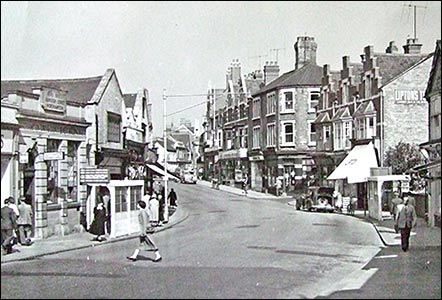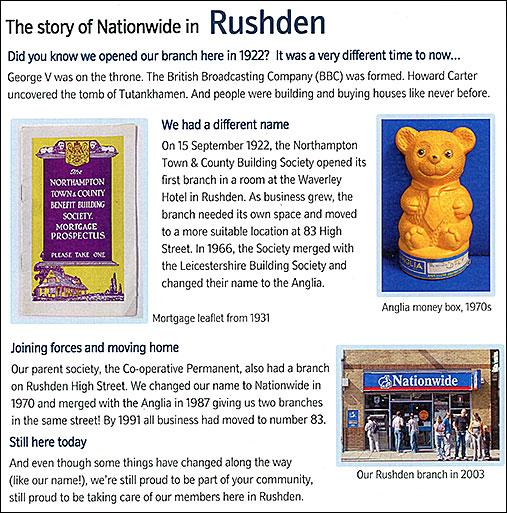|
|||
| The Rushden Echo, 1st March, 1929, transcribed by Gill Hollis |
|||
|
Building Society’s New Branch |
|||
|
|||
|
Pleasing Function at Rushden
The opening of the new Rushden branch office of the Northampton Town and County Benefit Building Society, in High-street, Rushden, took place on Wednesday. The new buildings replace the former offices in the Newton-road which were opened in 1923. [having first used a room at the Waverley]Nine Million People Living in Their Own Homes Interesting Speech by Alderman S. S. Campion
The New Office The Rushden office is one of a series of branch offices of similar design which the society is establishing, another at Luton being in the course of erection. The building is a one-storey erection of good height. The front elevation is faced with Darley Dale stone, finished with square sunk joints, the top portion being a simple but effective entablature carrying the society’s full name in bronze lettering. The whole is surmounted by a parapet having a type of pediment of modern design as a central feature. An attractive part of the building is the entrance doorway with its semi-circular arch and carved keystone, and the solid double doors and tracery fanlight which are in mahogany. In plan the building consists of a main banking hall, and private office, with other accommodation. The banking hall is 20 feet by 31 feet and is laid out in modern bank style, with a generous public space and a mahogany counter on two sides. An air of additional importance is given to the whole by a central circular dome, which contributes in an effective manner in the scheme of lighting. Mahogany panelling of simple impressiveness surrounds the walls up to a height of 5 feet, and centrally on the wall of the public space is the large fire-place. Quietness is given by the use of pleasant rubber floor covering, and the electrical installation in connection with the lighting of the banking hall is of a soft, diffused character, with free enclosed dust-proof fittings. The general contractors were Messrs. William Packwood and Son, Rushden; sub-contractors, electrical installation by Messrs. J. Baker and Son, Northampton; woodwork and joinery by Messrs. Whittington and Tomlin. The architect who had charge of the building is Mr. Frank Allen, A.R.I.B.A., Abington-street, Northampton. The Opening Ceremony Declaring the new buildings open, Alderman Campion said in reference to the status of building societies in this country the membership had doubled between the years 1918 and 1927, having attained the figure of £1,416,000. Assets had trebled during those years and at the end of 1927 were 223 millions, of which more than 197 millions had been invested in building mortgages. The extent to which societies had developed in the dominions and overseas was inconceivable. In the United States of America the latest figures available showed that the assets of building societies had reached the total of 6,250 million dollars – equal in sterling, taking the dollar to be 4s. 2d., to £1,302,083,333. Their figures for 1928 were not get available, but judging by the experience of their own society the figures would show a considerable increase, both in membership and in assets. Sir Enoch Hill, chairman of the National Building Societies, an association that consisted of something like 312 incorporated societies, had stated that some 500,000 houses were at the present moment being purchased through the facilities afforded by building societies, and 2½ million houses had already been purchased. Something like nine million people were living in houses purchased in this way. Sir Kingsley Wood had stated that in the eight years succeeding the Armistice, sanction had been obtained for housing to the value of £33,000,000. In the same time building societies had assisted with £235,000,000, more than seven times as much. He would drive home the fact that this great and glorious work had been done without the aid of the State or local authorities. Furthermore, their members had neither asked nor received assistance in this respect. They regarded their business as a mission of the most valuable character. History Tracing the history of the society Mr. Campion said it began in 1848 on a political basis, with the object of giving men the opportunity of securing the privilege of the forty shilling franchise. It developed by force of circumstances to help men to buy their own homes by easy instalments. The original Freehold Land Society became the Freehold Land and Building Society. The society worked in the best manner possible, so that to-day the best working-class districts in Northamptonshire were to be found on the society’s sites. The society could boast a greater proportion of working men owning their own houses that any other industrial community in the country. It embraced Wellingborough, Rushden, and other centres in the county, as well as areas round the county boundaries. The society offers a powerful appeal to those who consider purchasing their own houses as well as those investors desirous of investing their savings with a view of securing a moderate return and absolute security. Quoting figures to illustrate the growth of the society, Mr. Campion said that in 1913, the last complete year before the war, their membership was 5,574, and their assets £418,677. In 1919, the first complete year after the Armistice, their membership was 8,777 and their assets £841,832. On Dec. 31st, 1928, the 80th year of the existence, their membership was 32,423, and their total assets £3,414,257 – a four-fold increase in nine years. Among the 20 big societies in the country they were fourteenth in order of financial strength. With Sir Christopher Wren, the architect of St. Paul’s Cathedral, who said “If you ask for a monument, look around,” they might say “If you ask for a monument you find it in thousands of happy homes.” The Encouragement they had received in Rushden – a flourishing and growing town, with a population renowned for its policy of “Forward, Onward, and Upward” – has led to the conclusion that the erection of new offices would be justified by the results. Rushden was an important centre of the boot and shoe and allied industries. They believed that these offices would be convenient for the ancient and historic Borough of Higham Ferrers; for Irchester, with its reminiscences of Roman occupation; for Raunds, with its association with the boot and shoe industry, and Irthlingborough, with big interests of a similar character. Rushden was a populous and popular centre, convenient of access to a very considerable population. Its availability may be indicated by a few telling figures. The branch office was opened in 1923. They had 285 open investors’ accounts, and the total amount standing to their clients’ credit approached £45,000. From a rough estimate they had from 150 to 180 individual borrowers. They had lent to borrowers in the area served by the office something like £86,000. Mr. Campion quoted population returns to emphasise the growth of the area. In 1841 Irthlingborough had a population of 1,339, and in 1927 4,934, a four-fold increase. In the same period the figures for Raunds were 1,653 and 3,690. and for Higham Ferrers 1,402 and 3,120. Rushden’s population had increased, in the same period, ten-fold, the figures being 1,311 and 13,550. In conclusion, Mr. Campion, on behalf of the society, thanked the many friends of the society, who, knowing the good work it had been doing, had been glad to give it their cordial recommendation. Luncheon Luncheon was served at the Queen Victoria Hotel, Mr. and Mrs. C. W. Evans, the proprietors, catering efficiently. Alderman Campion presided. Proposing “The Town and Trade of Rushden,” Mr. Campion referred to his early associations with the town, which, he said, was now one of the most important towns in the county. Rushden had gone ahead because the local government had been characterised by a progressive spirit, and in religious and temperance matters Rushden had stood in the forefront in Northamptonshire. From what they knew of the past history of Rushden, they were sure it had a great future before it. They hoped for future development in the business of the building society, now that the new branch office was open, and they thought that the opening would be justified, believing, as they did, that the business would be multiplied in proportion to Rushden’s growth. Mr. Campion coupled with the toast the name of Mr. Tom Swindall, the chairman of the Rushden Urban Council, whose work in Rushden he had watched with great interest. Both Mr. Swindall and his wife had belonged to the church with which Mr. Campion was still connected. Responding, Mr. Swindall said Mr. Campion’s presence reminded him of the first 21 years of his life, which was spent in his native town of Northampton. He congratulated Mr. Campion on being president of such an important building society, which had done, and was still doing, a great deal towards the development of the county town. He was pleased to know that Mr. Campion was still active and vigorous – (applause) – and that he not only found time to devote to his society, but he also devoted himself to the government of the borough of Northampton and to social and religious work in that town. Mr. Swindall had always been interested in the society, and he remembered the time when the society first opened the East Park Estate in Northampton, about 1875 or 1880. He first had business dealings with the society when the late Mr. Thomas Adams came to Rushden in 1888, to survey a row of houses which he (Mr. Swindall) had built. As chairman of the Urban Council, he congratulated them on erecting such a magnificent building. They had done Rushden a great honour. Referring to the work of the Urban Council, the speaker said they had been alive to the need for houses, and during the past five or six years they had erected 295 workmen’s dwellings, they had 15 in course of erection, and architects were preparing for erecting a further 42. The motto of the building society was “Every man his own landlord,” and he might say they had a large number of people in Rushden who owned their own homes. A man who owned his own house was a better citizen, and he usually thought more of the welfare of the town. It was only possible for a working man to own his house through the help of such societies as theirs, and he was very pleased when he learned that the society’s old office in the Newton-road was not large enough to deal with the volume of business. He hoped the people of Rushden would take advantage, not only of the loan, but of the investment side, for if the society prospered then the prosperity of Rushden would follow. They had latterly passed through a shortage of work in the staple trade, but they now had hopes that things in future would be better. Trade had been bad, and he thought people should know that during such times allowances would be made even by building societies. It was impossible to get blood out of a post, and people could not pay if they were not earning money. Submitting “The Northampton Town and County Benefit Building Society,” Mr. C. Cross, C.C., paid a high tribute to the society and congratulated the directors and officials on having reached the three-million-pounds mark in the matter of assets. He said the branch would be a decided asset to the town of Rushden, and pointed out that house ownership tended to increase a man’s interest in the duties of citizenship, and added to his dignity and self-respect. In reply, Councillor A. P. Hawtin spoke of the wide field of the society’s activities, mentioning that they would shortly open another branch office at Luton. Mr. H. F. Preston also spoke. |
|||
|
|
|||

